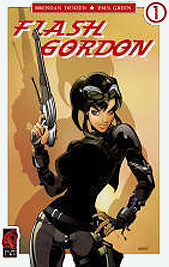Frank Frazetta: An Appreciation
 Frank Frazetta ushered in a new era of cover painting with heavily muscled heroes and lush, voluptuous women, evolving the pulp magazine style for more contemporary audiences. His work proved influential to writers, artists, and musicians for decades.
Frank Frazetta ushered in a new era of cover painting with heavily muscled heroes and lush, voluptuous women, evolving the pulp magazine style for more contemporary audiences. His work proved influential to writers, artists, and musicians for decades.
Best known for his series of covers featuring Conan the Barbarian on the Lancer paperbacks of the 1960s, he went on to create moody and evocative paintings for the Warren Magazines.
A child of Brooklyn, his artistic talents were evident early and by age eight, he was sent to the Brooklyn Academy of Fine Arts. He was mentored by Italian painter Michael Falanga who died before he could send young Frazetta to perfect his craft in Europe.
As the school closed in 1944, Frazetta sought ways to earn a living and drifted into illustrating comic books with several memorable Buck Rogers covers for Famous Funnies. He also drew several Shining Knight stories for DC Comics and displayed range with numerous funny animal stories as well.
By the 1950s, Frazetta was lending his talents to EC Comics, where he, Al Williamson and Roy Krenkel formed a powerful triumvirate, capable of masterful science fiction or fantasy stories.
Frazetta was hired by Al Capp to assist him on the popular Li’l Abner comic strip and he went on to also work with Dan Barry on Flash Gordon. The artist harbored his desire for a feature of his own and sold the short-lived Johnny Comet to the syndicates.




 Ardden Entertainment announced The Stand-In, a new title to be written by Jim Krueger (Avengers/Invaders). Described as a four-issue spy thriller mini-series, the project twill be illustrated by Alex Cal (The Amazing Spider-Man Family).
Ardden Entertainment announced The Stand-In, a new title to be written by Jim Krueger (Avengers/Invaders). Described as a four-issue spy thriller mini-series, the project twill be illustrated by Alex Cal (The Amazing Spider-Man Family). The Los Angeles Times
The Los Angeles Times The Flash Gordon Serials, 1936-1940: A Heavily Illustrated Guide
The Flash Gordon Serials, 1936-1940: A Heavily Illustrated Guide
 We here at ComicMix pride ourselves on being not only a comic book site, but also a pop culture site and so we cannot let the passing of House Peters, Jr. go by without noting it. The actor, born January 12, 1916, died from pneumonia on October 1.
We here at ComicMix pride ourselves on being not only a comic book site, but also a pop culture site and so we cannot let the passing of House Peters, Jr. go by without noting it. The actor, born January 12, 1916, died from pneumonia on October 1.  The actor stopped performing in 1967 but wrote an autobiography, Another Side of Hollywood, in 2000. There, he talked of being raised by actor parents during the silent film and early talkie days.
The actor stopped performing in 1967 but wrote an autobiography, Another Side of Hollywood, in 2000. There, he talked of being raised by actor parents during the silent film and early talkie days.
 Matt Manfredi and Phil Hay will adapt The Boys for the big screen according to The Hollywood Reporter. The Columbia Pictures’ project is based on the Garth Ennis/Darick Robertson series which first launched at WildStorm and quickly moved to Dynamite Entertainment.
Matt Manfredi and Phil Hay will adapt The Boys for the big screen according to The Hollywood Reporter. The Columbia Pictures’ project is based on the Garth Ennis/Darick Robertson series which first launched at WildStorm and quickly moved to Dynamite Entertainment.








